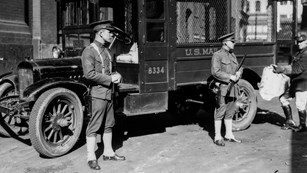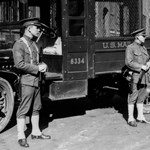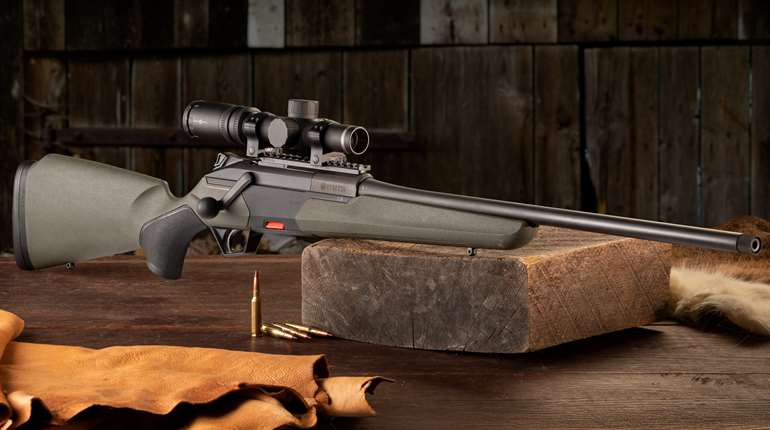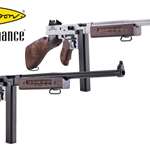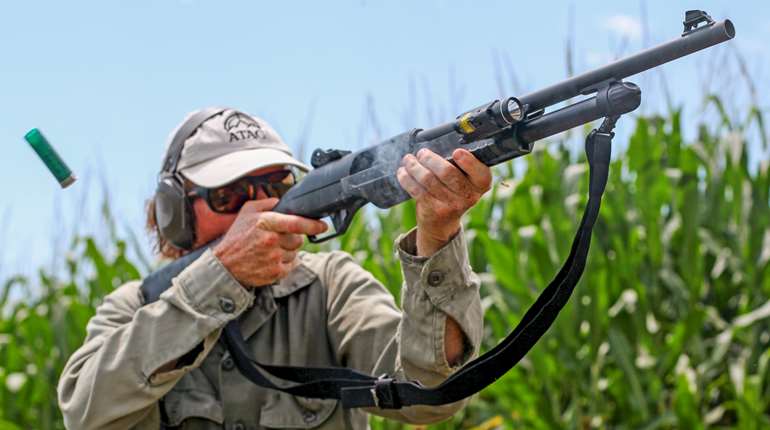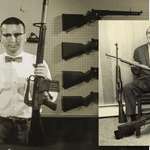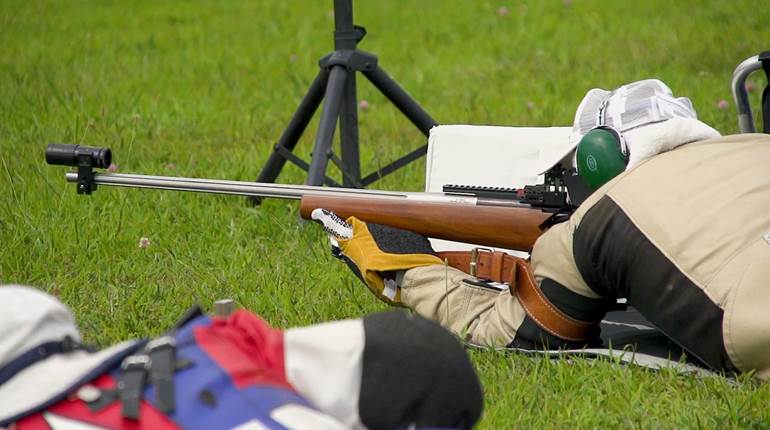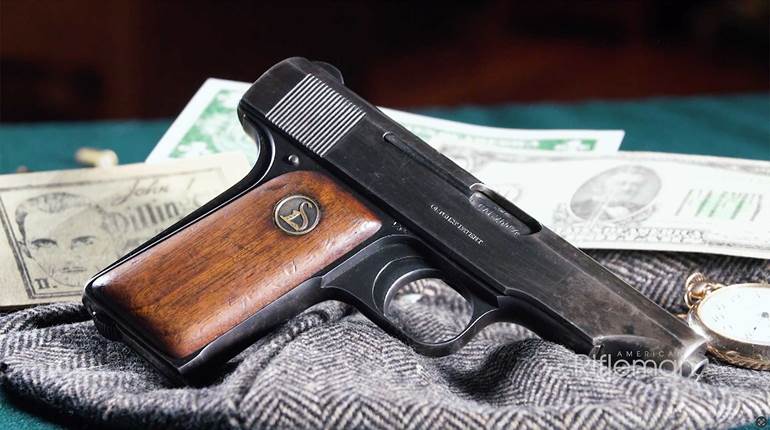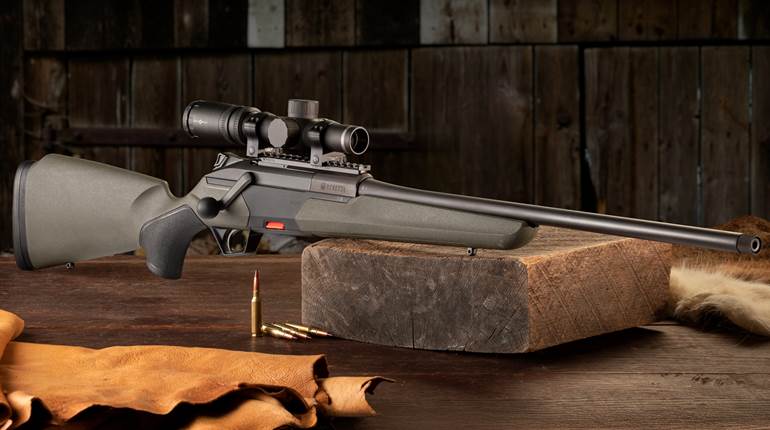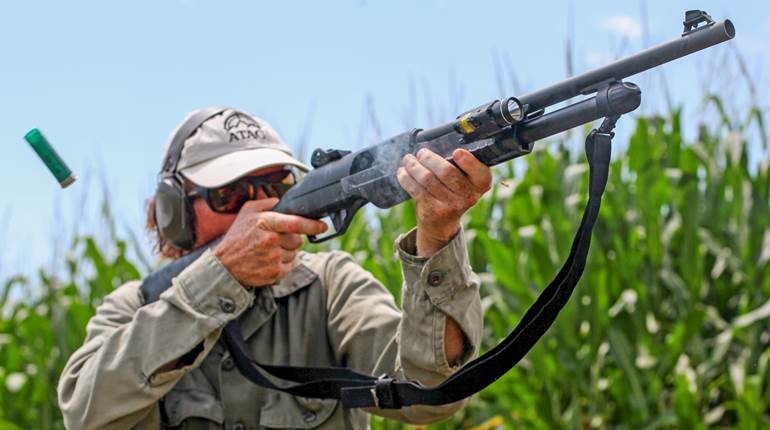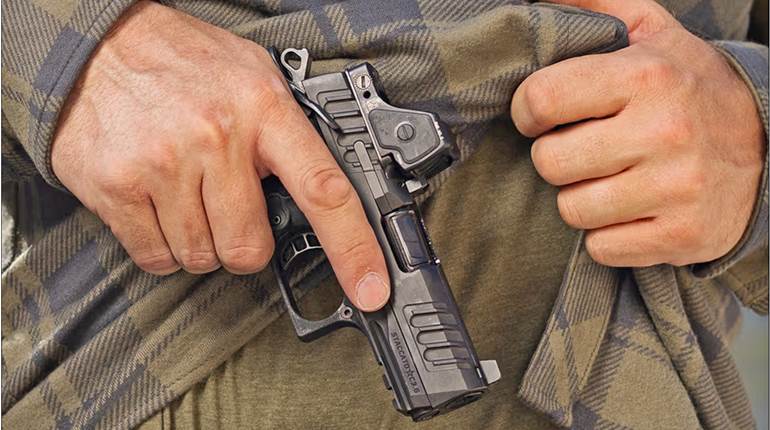
Resistance to Nazi oppression was hampered by the lack of civilian arms possession. One of the most notable exceptions was the Warsaw Ghetto Uprising in 1943, which began with a few incredibly brave Jews armed with handguns. They were able to temporarily stop the deportations of Jews to Nazi extermination camps.
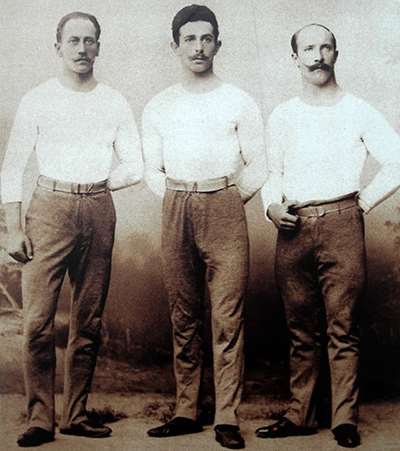
Alfred Flatow was a German Jew who won first place in gymnastics events during the 1896 Olympics. In 1932, he registered three handguns as required by a decree of the liberal Weimar Republic. The government warned that the police must carefully store the registration records so that no extremist group could ever obtain them. That feat was realized, however, when an extremist group led by Adolph Hitler seized power the following year and used those very same registration records to disarm “enemies of the state.” In 1938, the records were used to disarm Jewish gun owners such as Flatow, whose arrest report stated: “Arms in the hands of Jews are a danger to public safety.” He would later die in Theresienstadt concentration camp.
Shortly after confiscating firearms from Flatow and numerous other Jews, the Nazis instigated the pogrom known as the “Night of Broken Glass” (Reichskristallnacht) against a defenseless Jewish population.
All members of the German Jewish community were victims of the Nazi ideological pretext that every Jew was dangerous and must be disarmed. Given the premise that any Jew with a gun threatened the Reich, the universally cited excuse to ransack Jewish houses, businesses and synagogues during Reichskristallnacht was to search for and seize weapons of any kind. Those who actually possessed weapons had them seized and were subject to 20 years in a concentration camp.
Some personal reminiscences and other accounts relate these victims’ experiences, and some, though few, of the stories here show what kinds of self-defense were possible for Jews under threat of arrest and attack.
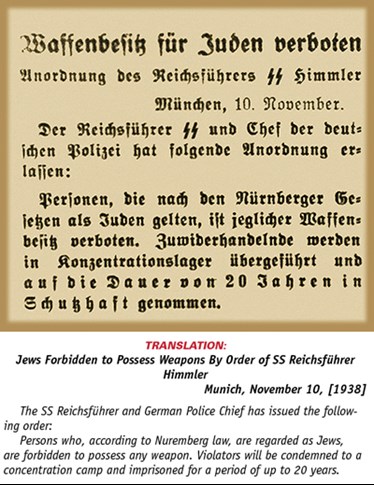 “This is a police raid! We are looking for arms in all Jewish homes and apartments, and so we shall search the orphanage too!” To these words in the early morning, Yitzhak Herz, caretaker of the children at the orphanage in Dinslaken, opened the door to two Gestapo officers and a policeman. They also searched for money, but found nothing and departed with the order: “Nobody is to leave the house before 10 a.m.! All the blinds of the building which face the street must be drawn! Shortly after 10 a.m. everything will be over.”
“This is a police raid! We are looking for arms in all Jewish homes and apartments, and so we shall search the orphanage too!” To these words in the early morning, Yitzhak Herz, caretaker of the children at the orphanage in Dinslaken, opened the door to two Gestapo officers and a policeman. They also searched for money, but found nothing and departed with the order: “Nobody is to leave the house before 10 a.m.! All the blinds of the building which face the street must be drawn! Shortly after 10 a.m. everything will be over.”
If orphanages and synagogues were not likely places to find arms, neither were businesses, but all Jewish premises were to be searched. In Hanover, the Schutzpolizei reported: “3d district: Specialty store for jackets at Sedanstrass has been searched for weapons. No other special events.” Obviously no arms cache was discovered at this clothing shop.
Frau Dzialowski of Mannheim recounted how three Nazis appeared at her apartment door with axes: “When I opened the door, they immediately started to provoke me, but I responded very calmly. ‘Where do you keep your weapons?’ … ‘Where is your money?’ To that I answered, ‘You have taken my husband away from his family; what else could you possibly want?’ … I sank to the floor in exhaustion and cried my heart out.”
Alice Oppenheimer recalled: “At our house [in Frankfurt am Main], the men searched my dad for weapons or something and then took him away. We learned later that all Jewish men between 18 and 60 had been arrested.”
Martha Hirsch, who had a sick father at the time, remembered the following details of the house search by Nazis at Frankfurt am Main: “The day that the assassination [of German diplomat Ernst vom Rath] took place in Paris, my father came home and cried. He said, ‘This is it, now terrible things will happen to us.’ Of course, we hardly expected the Nazis to burn down the synagogues and take the [Jewish] men to concentration camps, all in one night. But that was what we experienced. I saw furniture fly through windows and men arrested. My father was not sent to a concentration camp. He had a severe case of the flu and was lying in bed. He had not shaved and looked like he was close to death. The Nazis looked at him and said, ‘Let’s leave this one behind.’ I still remember the image of SS (Schutzstaffel) men standing in my bedroom. I was in bed when all of a sudden these brutes were standing in my room, ripping through my closet and searching for weapons.”
Adalbert Friedrich recalled how Nazis, while taking Jewish men into “protective custody,” searched for weapons and used their own weapons to kill a family’s dog: “As the highest party leaders had ordered, Jewish men were taken into ‘protective custody.’ At the Elkan house the Nazis took old Mr. Herz and his son Saly and locked them up in the cells of the firehouse together with Emanuel and Nathan Elkan. The houses of the Jews were searched for ‘suspicious documents’ and ‘weapons.’ When a German Shepherd dog put up resistance at the house of Emanuel Rosenbaum, the Nazis killed him with a shot from a pistol.”
Some Jews who still possessed firearms sought to comply with the confiscation orders. The Sinzheimers, a Jewish family with two children, lived in a large apartment on Uhlandstraße in Berlin. Mr. Sinzheimer was in Paris on business on the evening of Nov. 10, when Mrs. Sinzheimer heard shouting, glass being smashed and shooting. Family friend Herr Müller showed up at the door with a large revolver, informing the family of his intention to defend them and to shoot any of “those bastards” who would lay a hand on members of the family. At around 6 a.m., she heard over the radio an announcement that any Jew found in possession of a firearm would be shot at once. Mrs. Sinzheimer knew that the fact that her husband had a license for his handgun would mean nothing to the Sturmabteilung (SA) if they found it. She called a friendly repairman to break open the secret drawer where the firearm and license were hidden. She then placed the handgun and license in a box of cigars and carried it to the local police station on the Kurfüstendamm. She asked to see a sergeant whom she knew well and presented him with the box of cigars. When he discovered the gun license and handgun, he threw the gun in the garbage when no one was looking and exclaimed: “Hurry home, Frau Sinzheimer, before you give me a heart attack!”
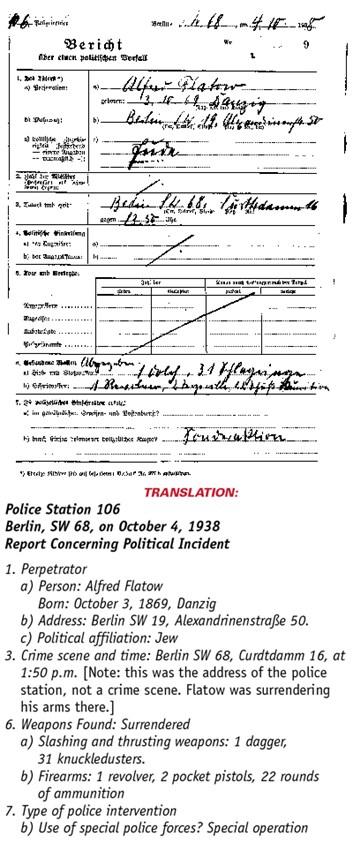 Major Friedrich Solmitz of Hamburg was a highly patriotic, decorated World War I veteran. Although a Protestant convert, he remained Jewish according to the Nuremberg Laws. His wife, Luise, a non-Jewish conservative schoolteacher, kept a copious diary. She described a fearful atmosphere on Nov. 11, when she and her friend “Gi.” went to town and observed destruction and boarded-up windows. No Jews were seen among the silently moving crowd. “In the evening I went to the block warden to discuss the surrender of weapons. Gi. and I had read on the street that Jews had to surrender all firearms as well as stabbing and cutting weapons to the police within four days.” Frau Solmitz continued (referring to Friedrich as “Fr.”): “Fr.’s beautiful hunting rifle, the weapons he used in the war. Everywhere there was bitterness, nowhere a glimmer of empathy, hope, not even a little breather. ... After I had read about the weapons surrender, I rushed home. I was concerned about Fr., relieved when we found him. … It was hard for those who had never violated their duty to the state and had never been unfaithful to the mother country. Himmler’s decree threatens concentration camp and protective custody of 20 years (!) for those who fail to surrender their weapons.”
Major Friedrich Solmitz of Hamburg was a highly patriotic, decorated World War I veteran. Although a Protestant convert, he remained Jewish according to the Nuremberg Laws. His wife, Luise, a non-Jewish conservative schoolteacher, kept a copious diary. She described a fearful atmosphere on Nov. 11, when she and her friend “Gi.” went to town and observed destruction and boarded-up windows. No Jews were seen among the silently moving crowd. “In the evening I went to the block warden to discuss the surrender of weapons. Gi. and I had read on the street that Jews had to surrender all firearms as well as stabbing and cutting weapons to the police within four days.” Frau Solmitz continued (referring to Friedrich as “Fr.”): “Fr.’s beautiful hunting rifle, the weapons he used in the war. Everywhere there was bitterness, nowhere a glimmer of empathy, hope, not even a little breather. ... After I had read about the weapons surrender, I rushed home. I was concerned about Fr., relieved when we found him. … It was hard for those who had never violated their duty to the state and had never been unfaithful to the mother country. Himmler’s decree threatens concentration camp and protective custody of 20 years (!) for those who fail to surrender their weapons.”
Frau Solmitz wrote again on Nov. 12, describing what happened when she and Friedrich went to the Gestapo office at the city hall at Stadthausbrücke: “Fr. had not yet read the weapons ordinance, otherwise he would not have submitted a request to keep his sword and pistol from the war. The two SS men who were dealing with us in the entrance hall were a bit astonished. ‘Retired major?’ said one of them. The official on the floor above said dryly: ‘That is over now.’ He added: ‘If I may give you some advice, surrender all your weapons.’ Fr. responded that as a former officer he would of course do that.”
Herr and Frau Solmitz returned home and were about to leave when two plainclothes men from the Gestapo rang the doorbell. They wished to speak with Friedrich alone, but Luise overheard the conversation. They asked about his medals, he responded that he had “all kinds of medals from the war,” and they then wanted to see the documents. Asked whether he was a pilot, he responded that he was one of the first German air force officers and was 50 percent disabled in service. “Fr. said that we had just returned from the Gestapo where we discussed the surrender of weapons. To the official’s question whether he had any weapons, he said, ‘Of course, I am an old officer.’ The official responded, ‘Make sure you surrender them all.’ Fr. repeated that of course he would do so and asked for the reason of this visit. The officials responded that the fact that they were leaving now was proof that everything was in good order.” He exemplified patriotic German Jews who owned firearms and who had no subversive thoughts whatsoever, but who were disarmed because they were Jewish.
Victor Klemperer, too, had served honorably in Germany’s armed forces during World War I, had retired as a university professor in 1935 and was a resident of Dresden. His acclaimed diary includes the following entry: “On the morning of the eleventh two policemen accompanied by a ‘resident of Dölzschen.’ Did I have any weapons?—Certainly my saber, perhaps even my bayonet as a war memento, but I wouldn’t know where.—We have to help you find it.—The house was searched for hours ... . They rummaged through everything, chests and wooden constructions Eva had made were broken open with an ax. The saber was found in a suitcase in the attic, the bayonet was not found. … ‘At four o’clock I was on the street again with the curious feeling, free—but for how long?’”
Numerous other Jewish veterans of World War I possessed firearms or edged weapons. More than 100,000 of the 550,000 Jews in Germany had served in the German army in the Great War, 12,000 had been killed in action, and more than 30,000 had won decorations. In the Austro-Hungarian Empire, 300,000 Jews had served, 24 of them achieving the rank of general.
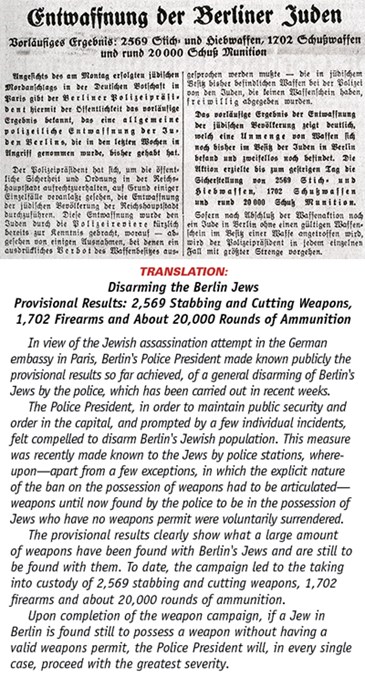 Dorothy Baer, who was 15 at the time, recalled how the Nazis did not find her father’s revolver at their residence in Frankfurt am Main because her mother had hidden it on her person and later managed to throw it away: “That day the terror started towards the evening. I remember four or five terrifying men crashing through our front door and starting to systematically destroy the apartment. My dad had a heart ailment and was lying in bed that day. My mother was taking care of him while I accompanied these terrible men from one room to the next. ... I kept telling them that my father was on his death bed. … I have often been asked why we did not fight back. I believe that individuals were not able to fight back at all. Maybe only groups of people could have offered resistance. I remember that my dad had a small revolver, which he kept in his nightstand, probably illegally. I am convinced that he did not have any bullets for it and doubt that he knew how to shoot. That evening, after the Germans had ransacked our apartment, mother said to me: ‘Put on your coat, we are going for a walk.’ This was odd, but I went along. Mother had the small revolver with her and ‘lost’ it as we entered a park. She wanted to avoid being caught with a weapon. The next morning we learned that many [Jewish] men had been arrested and sent to concentration camps.”
Dorothy Baer, who was 15 at the time, recalled how the Nazis did not find her father’s revolver at their residence in Frankfurt am Main because her mother had hidden it on her person and later managed to throw it away: “That day the terror started towards the evening. I remember four or five terrifying men crashing through our front door and starting to systematically destroy the apartment. My dad had a heart ailment and was lying in bed that day. My mother was taking care of him while I accompanied these terrible men from one room to the next. ... I kept telling them that my father was on his death bed. … I have often been asked why we did not fight back. I believe that individuals were not able to fight back at all. Maybe only groups of people could have offered resistance. I remember that my dad had a small revolver, which he kept in his nightstand, probably illegally. I am convinced that he did not have any bullets for it and doubt that he knew how to shoot. That evening, after the Germans had ransacked our apartment, mother said to me: ‘Put on your coat, we are going for a walk.’ This was odd, but I went along. Mother had the small revolver with her and ‘lost’ it as we entered a park. She wanted to avoid being caught with a weapon. The next morning we learned that many [Jewish] men had been arrested and sent to concentration camps.”
Incidents occurred in which brave individuals used firearms to impede the pogrom. Wichard von Bredow, landrat (chief executive) administrator for the town of Schirwindt in East Prussia, was ordered by the gauleiter (the Nazi provincial governor) to burn down the local synagogue. He decided instead to risk his life to protect it. When the Nazis arrived with incendiary materials, he loaded his revolver in front of them, making clear that they could proceed only over his dead body. They fled, leaving it the only synagogue in the district not destroyed. Bredow would suffer no punishment for his defiance.
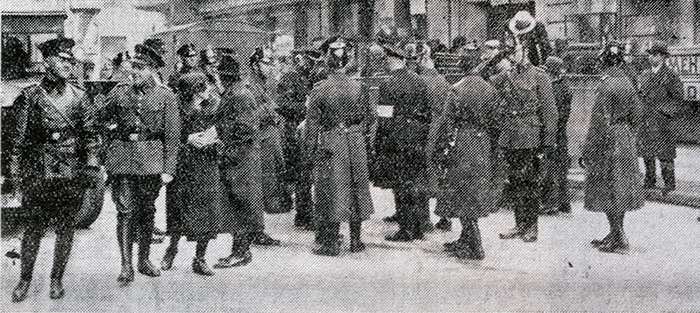
Similarly, a coal merchant who was Christian pulled a firearm on Nazi arsonists to save a synagogue in Sontheim. He accompanied Jews away from the town to prevent their arrest.
Historian Mitchell Bard has noted that “Jews rarely offered resistance to their attackers since they were unarmed and typically faced groups of men who had sticks, knives, iron bars, guns and other weapons.” A Jewish family in Heilbronn pushed an SA man out of the window, and in Hilden a mother and son who resisted were murdered with an axe, and another person was stabbed to death.
International media coverage was sympathetic although not necessarily well-informed. The Chicago Tribune reported only eight arrests of Jews for possession of arms in violation of Himmler’s decree threatening 20 years in a concentration camp. However, the newspaper also reported personal stories. A Jewish scientist from Berlin told its reporter how at 6 a.m. on Nov. 12, a Nazi official in a brown uniform and four assistants in civilian attire took him from his home, only to order him to go back there. Many of his friends who were arrested were not so lucky. A friend’s home was searched for weapons by six men, who broke the china and smashed furniture. The scientist related: “Only one thing they had missed—an old army revolver which was lying in a drawer of a table in my friend’s bedroom. That rusted weapon, probably fired for the last time in 1918, might have gotten him twenty years in a concentration camp.”
The American consulate in Stuttgart, headed by Samuel W. Honaker, reported to U.S. ambassador Hugh R. Wilson in Berlin on Nov. 12 that “the Jews of Southwest Germany have suffered vicissitudes during the last three days which would seem unreal to one living in an enlightened country during the twentieth century.” He described the horrors of Nov. 10, from torching of synagogues before daylight to the midnight arrests.
He continued: “So great had become the panic of the Jewish people in the meantime that, when the consulate opened after Armistice Day, Jews from all sections of Germany thronged into the office until it was overflowing with humanity, begging for an immediate visa or some kind of letter in regard to immigration which might influence the police not to arrest or molest them. Women over sixty years of age pleaded on behalf of husbands imprisoned in some unknown place. ... Men in whose homes old, rusty revolvers had been found during the last few days cried aloud that they did not dare ever again to return to their places of residence or business. In fact, it was a mess of seething, panic-stricken humanity.”
Honaker learned that “practically the entire male Jewish population of the City of Stuttgart, ranging from the age of 18 to 65 years, has been arrested by authorities representing the police.” On Nov. 11, some of the prisoners were taken to Welzheim, a concentration camp in Württemberg. Reichskristallnacht ended, but not before countless other incidents like these had unfolded in the dark hours.
At the end of that pogrom, Germany’s Jews were largely disarmed. The Nazis saw that an apparent majority of the “Aryan” population was too cowed and intimidated by the dictatorship to protest. With what would become the largest, most persecuted group of victims now virtually defenseless, Hitler’s plans could move forward.
No foundation would exist for any effective resistance movement or individual acts of resistance. The way was paved for total repression.
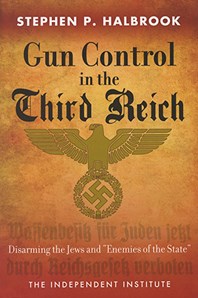 Gun Control In The Third Reich
Gun Control In The Third Reich
Stephen P. Halbrook’s Gun Control In The Third Reich: Disarming The Jews And “Enemies Of The State” documents perhaps the most diabolical gun control effort of the 20th century. Based on newly discovered documents from German archives, diaries and newspapers of the time, the book—from which this article is excerpted with permission—presents the definitive, yet hidden history of how the Nazi regime made use of gun control to disarm and repress its enemies and consolidate power. Hardcover, 280 pp. Price: $20. Contact: The Independent Institute, 100 Swan Way, Oakland, CA 94621; (510) 632-1366; independent.org.








